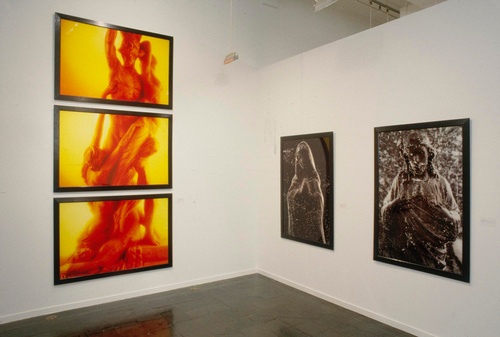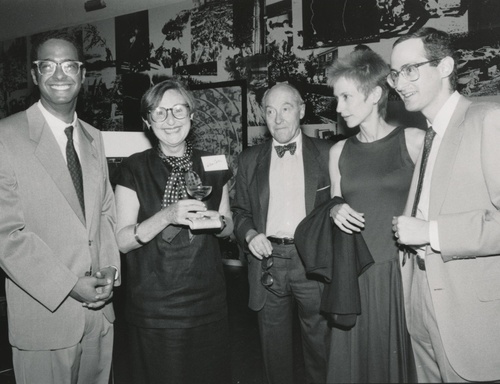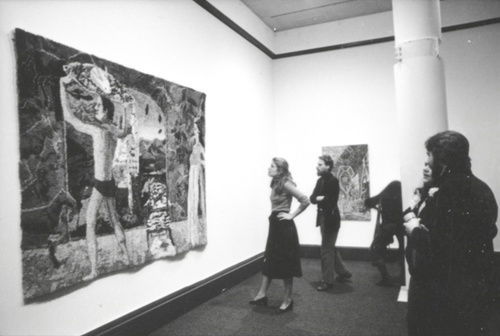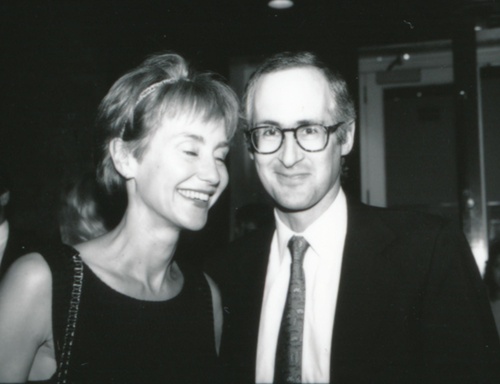
JoAnn and Paul Schnell at the opening of “Temporarily Possessed: The Semi-Permanent Collection,” New Museum, New York, 1995
Oral History: Paul Schnell
Trustee, 1988 - present
Interviewee: Paul Schnell, New Museum Trustee
Interviewer: Dennis Szakacs, New Museum Associate Director
April 26, 2017 at the New York Offices of Skadden Arps
Dennis Szakacs: Okay. Wednesday, April 26, 2017. Interview with Paul Schnell at the Offices of Skadden Arps, midtown Manhattan… A foggy day, but bright here in the conference room with Paul. How are you doing?
Paul Schnell: The New Museum light shines through. I’m doing well. Thank you, Dennis.
Dennis Szakacs: Well, it is so wonderful to sit down with you and talk about your role in the New Museum’s history, which is long and substantial. I think you may be one of the longest-serving trustees at this point.
Paul Schnell: A long time.
Dennis Szakacs: I would love to hear about the beginnings of it all. How you found out about the Museum. When you first met Marcia Tucker, and what attracted you to the whole, crazy endeavor.
Paul Schnell: Well, it’s been a wonderful ride. I’ve always been interested in contemporary art. My mom is still an artist and exposed me a lot to contemporary art when I was growing up, and my grandfather was in the art business. In the early 80s, I went to a talk that Marcia Tucker was giving at the New School . It was, to this day, one of the most extraordinary talks I’ve heard anybody give about any topic. Marcia still remains to me the person who talked in the most interesting way about contemporary art. In those days, there was almost a cult-like following that developed around Marcia, and I was drinking the Kool-Aid, like everyone else.
I met Marcia at the reception after her talk and we just started to talk back and forth a little bit. I saw her at an exhibition at the New Museum at the New School even before [the Museum relocated to] 583 Broadway in 1983. I met with her to talk about – I owned a huge outdoor stone sculpture, and we talked a little bit about trying to find a home for it in the east coast (that never came to pass).
And just in the course of getting to know Marcia, and some other people around the Museum, they approached me and said, “We’d like to have a young member of the Board.” – this shows you how long ago this was, when I was the youth movement on the Board of Trustees – they’d “like to have somebody who doesn’t live on the Upper East Side, or outside the city” – I was living in SoHo at the time – “[to] get involved.” So, I joined the Board, probably 20 years younger than anybody else on the Board at the time. I think I was maybe the only one who felt it was safe to be in SoHo at nighttime, among the Board.
That’s really what drew me to the Museum. It was really Marcia, and it was her talking about contemporary art.
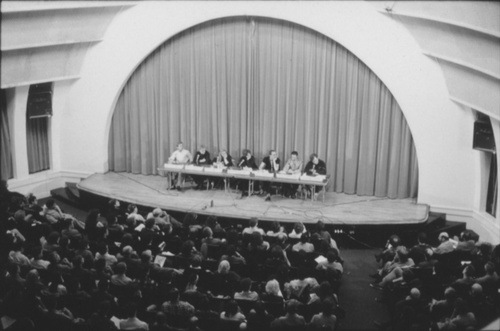
From 1977 – 1983 the New Museum was located at the New School for Social Research graduate center at 65 Fifth Ave. Above: New Museum panel “What is the Impact of Homosexual Sensibility on Contemporary Culture?” New School Auditorium, 1982. Photo: Charles Schwefel

Marcia Tucker, New School Auditorium, 1982. Photo: Charles Schwefel
Dennis Szakacs: Do you remember some of the things she said at that talk, still? Or it’s just the feeling of it that stays with you?
Paul Schnell: It was the feeling. To this day, it remains the core, I think: value and mission. It was her way about challenging the status quo in the broadest sense. Certainly in terms of an art world sense. You know, she was an outsider looking at the art world from the outside, challenging notions of what contemporary art is – I remember she showed an image of Piss Christ, Andres Serrano’s work, very early on in the days – and, sort of [questioning] what kind of roles could [or] should art be serving in a societal sense? And so, those are themes that were all there from –
Dennis Szakacs: Right. From the beginning?
Paul Schnell: – Yeah.
Dennis Szakacs: So what was it like on the Board in the early days? Talk a bit about the culture, the Board, and the Board’s interaction with the staff, and how the museum operated.
Paul Schnell: It was hand to mouth existence. I remember well into my tenure, not even at the beginning, our breaking the million-dollar budget level, which we’re now more than 10 times that. I remember the first couple of benefits, if we could raise $50,000, that was a big. Obviously, we massively exceeded that later on. I remember trustees doing some of the cooking for the benefits. It was a shoe-string budget. We were in budget crisis every day of every year, and in a sense that kept us lean and on our toes.
And there was and has always been, and down to this day, there was this really deep sense of a shared mission and of a shared passion for contemporary art, and for what the New Museum stood for. It was really different than what I saw of other museums and other museum boards.
And in a funny way, people have asked me, “How did you help as a Board member of the Museum?” I think in a way the most important thing we did as Board members at that time was to keep our hands off what curators and staff were doing. I mean, I can’t ever remember – and we were doing some very controversial shows – appropriating corporate symbols in a Hans Haacke show. I mean, we were doing some very challenging stuff and I never heard anybody on the Board, question or try to put the brakes on what the curators wanted to do. On the contrary, it really it had sort of a very strong level of support for the Museum to do what it wanted to do.
Even recognizing that maybe things like fundraising were challenging. It is hard to think in this day and age, where we’re sought after by corporations for the fact that we think about new ideas and new art. The fact that we have this amazing young demographic in our audience. We went several decades without getting a penny’s worth of corporate support. We had some entrepreneurial, very successful Board members. But in terms of staff of the established corporate America – they didn’t like us. And we knew that we could put on shows that would challenge the established order even though it would turn away our corporate support. So in that sense, it was very exhilarating for the Board, really, to feel like you were part of this very important mission.
Dennis Szakacs: So, it did feel new and different? And distinct from what was happening in the other museums in the city?
Paul Schnell: Yes. No question about it.
Again, when you think about how things have been transformed if you were interested in Contemporary art, the New Museum was the only museum that really followed what was going on in contemporary art, in a sort of current, at the moment, where is art going in the future?, kind of way. contemporary artists weren’t being shown at other museums. Artists would have had to have passed … enough time and enough of a period of being accepted to be shown at the other museums.
You know, we never showed accepted artists. It was pre-accepted. So, that’s was what made it so much fun to go to the New Museum . The big collectors in those days were buying great masters, impressionist artists were setting auction records, and nobody was really buying into – for big money – contemporary art. And so the other museums really weren’t going after contemporary art. There were really no major, or very few major collectors of contemporary art back in that time. And they were not focused on contemporary art. Again, when you think of how that’s changed in the same age group, the Met Breuer, and the focus that so many museums now have on contemporary art, that’s changed.
So, it really was different, and everything was different about the Museum.
Marcia made a decision at one point to say - we had some great museum, guards - and said, “You know, they spend more time thinking about this art than any of us do.”
Dennis Szakacs: Right, right.
Paul Schnell: – and all of a sudden, our museum guards started going up and approaching people there to see shows, just sort of engaging them, you know, “What do you think?” “Have you seen this?” or whatever. And it was just – it was so radical. At other museums, the guards are there to be invisible, and here they were coming up to our visitors to engage them in the work.
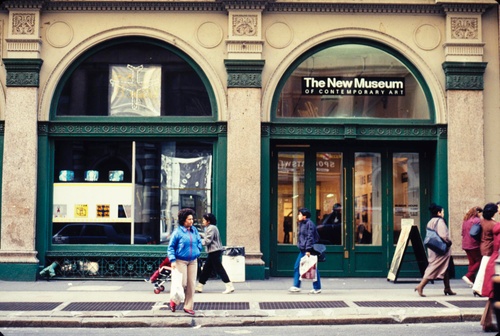
From 1979 - 2004, the New Museum used street-level windows as a temporary exhibition space for artists to install new site-specific works. Above: Installation by Robin Ticho, the New Museum’s location at the Astor Building in Soho, 1985

New Museum guard Kimball Augustus describing artworks to visitors as part of the “Security and Admissions Project.” Gallery view: “The Spatial Drive,” New Museum, New York, 1993. Photo: Fred Scruton
Something that simple was really radical. I think, in a way, we took what was invisible in so many senses and made it visible and brought attention to it, whether it was museum practices or artists.
Dennis Szakacs: So, the Museum started growing, becoming more visible, parallel to the growth of contemporary art, really, as more of a market phenomenon. Tell me a little bit about how that growth happened and its impact on the Museum and on the Board.
Paul Schnell: There’s an under sort of current, or underlying theme to how we have evolved, which is: Will success spoil the New Museum?
We excelled on being on the outside. We excelled on challenging the established order in the art world. We got a lot of bad reviews in the old days and Marcia would always say that, “That review validates what we’re doing. We are ahead of the art world.” And there was some truth to that. It was also a wonderful way to rationalize away a bad review, but there was some truth to that. We were on the outside and we were not welcome to come in. And in that sense, it made it much easier for us to be challenging, to think about the new, and to be at the vanguard of new ideas.
As we have achieved our success through Marcia, through Lisa, through great leadership, great staff, we’ve moved from the edge much more into the mainstream. Again, the notion that established collectors would be more interested in contemporary art than any other form of art now seems obvious, but that was not at all the case back then.
I think that’s become our biggest challenge. That [question of], can you both be in the mainstream, and be successful, and well-recognized, and get support from corporations, and still be true to our mission? … I’ve gone from being a young member of the Board – the youngest – to one of the oldest. But I still feel, in terms of spirit, that my role there is to make sure that we maintain that sense of challenging the status quo, now that we’ve become a part of the status quo, or not letting ourselves become the status quo. So, yeah, evolution has been extraordinary. And, obviously, we must have been doing something right, in that we’ve attracted so much more support and recognition. But that’s a huge challenge for us.
